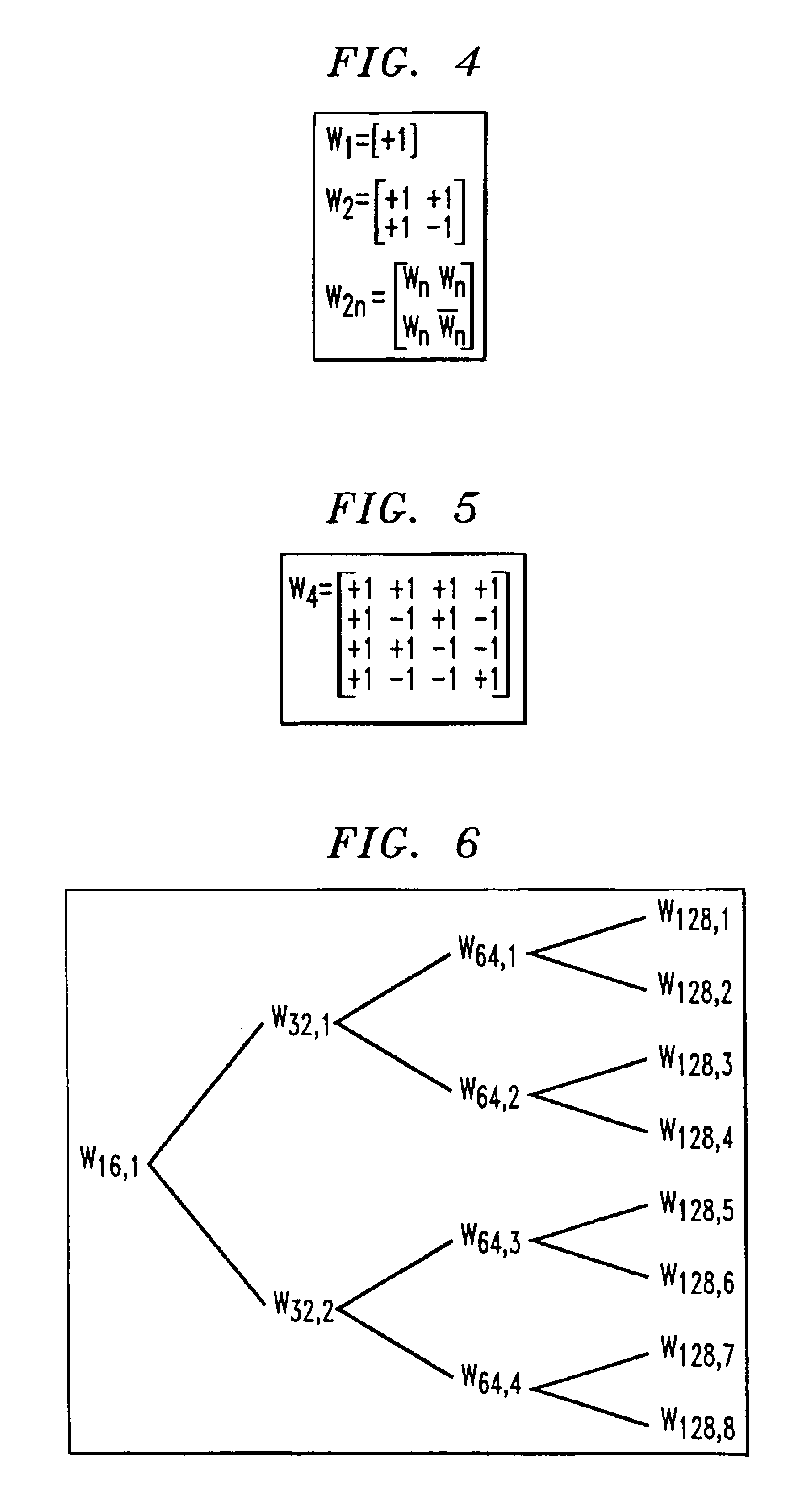Method for data rate selection in a wireless communication system
a wireless communication system and data rate selection technology, applied in the field of wireless communication, can solve the problems of not being able to reasonably compute the optimal data rate supportable per cell, the active leg cell will fail in helping the mobile, and the maximum rate supportable, so as to improve the speed of cell selection and maximize the rate supportable
- Summary
- Abstract
- Description
- Claims
- Application Information
AI Technical Summary
Benefits of technology
Problems solved by technology
Method used
Image
Examples
descriptive example
[0040]In the following table 1, we will use a single threshold, such as 50% of the available code power or space, that demarcates each resource (power and code space) as either high or low. Depending on the combination of these resources, the contexts are defined as Linear (L), Walsh limited (WL) and power limited (PL).
[0041]
TABLE 1RESOURCECodesCodesCOMBINATIONHIGHLOWPower HIGHLWLPower LOWPLL
[0042]In the linear (L) region, the code space (bandwidth) and power resources in the cell decrease in direct proportion to each other. For example, they could both have high values (16 W of power and 16 codes) or can both have low values (1 W of power and 1 code) or intermediate values (2W of power and 2 codes). In all cases, the rate per code of a user with a certain fixed channel condition will nearly be a constant since the power available per code in both cases is unity. Of course, the net multi-code rate will be 16 times larger in the former case than in the latter. In any event, the rate ...
case i
[0075]Two fingers assigned by the data mobile m to multipath rays from serving cell 1 to recover energy and one finger assigned to neighboring cell 2 to decode control information:
Ec / Nt (l,m,k) Ec / Nt(1,m,k)=(Eb / Nt)PG·=ς1d(k+d)·(c1 / (c1+c2)){[φ1·(I0 / Ec1sum)-Ψ1d(k)-(ς1d(k)+ς1vo(k))·(1-c1)(c1+c2)]·(c2d(k+d)+ς2vo(k+d))(ς2d(k)+ς2vo(k))+(1-c1)(c1+c2)·(ς1d(k)+ς1vo(k))}+=ς1d(k+d)·(c2 / (c1+c2)){[φ1·(Io / Eclsum)-Ψ1d(k)-(ς1d(k)+ς1vo(k))·(1-c2)(c1+c2)]·(ς2d(k+d)+ς2vo(k+d))(ς2d(k)+ς2vo(k))+(1-c2)(c1+c2)·(ς1d(k)+ς1vo(k))}EQUATION A1
where:[0076]k is the instant of measurement, i.e when the reverse feedback rate per code and antenna information (RAI) is computed[0077]k+d is the instant of prediction, i.e. time of data reception; d is approximately three slots (3.75 ms).[0078]ζdj is the traffic power fraction allocated to TDM packet data channel in cell j.[0079]ζvoj is the voice+overhead power fraction allocated to the CDM channels in cell j.[0080]Ψdj is the indicator functi...
case ii
[0089]One finger assigned to a ray from serving cell 1 to recover energy and two fingers assigned to neighboring cells 2 and 3 respectively to decode control information. Ec / Nt(1,m,k) =(Eb / Nt)PG·=ς1d(k+d)·{[φ1·(Io / Eclsum)-Ψ1d(k)-(ς1d(k)+ς1vo(k))·(1-c1)c1]·[(c2d(k+d)+ς2vo(k+d))(ς2d(k)+ς2vo(k))β2(β2+β3)+(c3d(k+d)+ς3vo(k+d))β3(ς3d(k)+ς3vo(k))(β2+β3)]+(1-c1)c1·(ς1d(k)+ς1vo(k))}EQUATION A2
where, in addition:[0090]βj is the ratio of path losses to the mobile of neighbor cell j to serving cell 1. This is estimated as the ratio of the pilot energy of cell j to that of cell 1 assuming equal pilot power fractions.
[0091]The Ec / Nt in the above expression is divided by M where M is the number of W-ary (e.g. W=16) Walsh codes available in D2. This yields the desired C / I per code for the cell 1.
PUM
 Login to View More
Login to View More Abstract
Description
Claims
Application Information
 Login to View More
Login to View More - R&D
- Intellectual Property
- Life Sciences
- Materials
- Tech Scout
- Unparalleled Data Quality
- Higher Quality Content
- 60% Fewer Hallucinations
Browse by: Latest US Patents, China's latest patents, Technical Efficacy Thesaurus, Application Domain, Technology Topic, Popular Technical Reports.
© 2025 PatSnap. All rights reserved.Legal|Privacy policy|Modern Slavery Act Transparency Statement|Sitemap|About US| Contact US: help@patsnap.com



